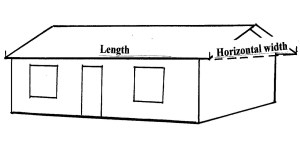Short description:
General ways to collect water for drinking, for livestock or irrigation
Introduction
Rainwater running off land surfaces can be harvested, stored and utilized using a technique called rainwater harvesting instead of being wasted in rivers, lakes and the sea.
Rainwater harvesting consists of 5 components:
- Rainfall
- Catchment areas, also called watersheds, onto which the rainwater falls.
- Gutters, or conveying channels, to bring rainwater from a catchment area to storage reservoir.
- Storage reservoirs can be tanks, ponds, dams and in situ storage in sand and soil.
- Retrieval water is extracted from reservoirs either by gravity or by pumps and lifts.
A rural homestead should preferably have the following variety of structures for harvesting rainwater to avoid water shortages during dry seasons:
1) A roof catchment system for clean domestic water that consists of gutters fixed to the roof which drain the rainwater into a storage tank. The size of a storage tank depends mainly on the financial capacity of the owner and to a lesser degree on the size of the roof and the volume of rainfall. However, the ability to supply sufficient water during years with drought depends on the size of the roof and the tank.
2) A pond or an earth dam for watering livestock and garden irrigation can be excavated by hand or animal drawn implements at a low place in the farmland where rainwater flows, or accumulates, during rainy seasons. Ponds and dams can initially be built small and enlarged during the following dry seasons until they might supply water throughout the years.
3) A hand dug well may supply water if sunk into shallow ground water, e.g. downstream of an earth dam or near evergreen trees growing on riverbanks.
In situ harvesting of rainwater in farmland increases the yield of crops and will often determine whether there will be anything to harvest at all. Most farmers know and apply some of the techniques of soil conservation that make rainwater percolate into the soil instead of eroding the farmland. Among several techniques, the following are being used by many farmers:
- Contour planting in horizontal ploughing lines.
- Contour trash lines with grass and farm waste.
- Contour ridges that develop into terraces.
- Contour bunds of stones that develop into terraces.
- Bench terraces that develop slowly from contour ridges.
- Micro catchments with U and V shaped soil bunds for growing grass and crops and trees.
- Trapezoidal bunds with a farming area of 1,350 m2 (1/3 acre) for grass and crops.
- Cut-off drains to discharge surplus rainwater run-off into gullies with check dams and streams.
- Check dams of stones and vegetation to heal eroded gullies.
- Check dams of stones and vegetation in valleys.
For more information on soil conservation measures
The water cycle
Every living creature and vegetation must have water in order to survive.
Only 3% of all water on Earth is fresh water and 68% of the water is frozen ice on the North and South Poles. All humans and most animals as well as nearly all vegetation can only survive on fresh water free of salt and minerals. Water for irrigation must also be fresh water and applied sparingly by flood, furrow or drip irrigation, otherwise the irrigated soil will turn saline and unproductive for many years to come.
The other 97% of the water on planet Earth is saline seawater in which whales, fish, corals and plankton flourish. Slightly salty water may be used for watering livestock and other animals, although fresh water is healthier.
Nearly half of all deep boreholes are dry or contain saline (brackish) water with minerals harmful to humans, animals and plants. Where fresh water is pumped up from very deep boreholes it is called mining fossil water because the water withdrawn cannot be replaced by rains.
Therefore, there are only two sustainable solutions to the world's increasing demand for water, namely rainwater harvesting and water conservation.
Fresh water sources are replenished in a water cycle through the following activities:
- Evaporation is an almost invisible vapour rising from water surfaces.
- Transpiration is evaporation from vegetation and soil surfaces.
- Precipitation from clouds falls as fogs, mists, rains, hails and snow.
- Rainwater run-off is rainwater running off all kind of surfaces.
- Drainage is the ability to drain excess water away from catchments.
- Infiltration is the movement of water into the soil from the surface.
- Percolation is the movement of water through the soil to the underground layers.
- Permeability is the rate at which water penetrates through soils down into the underground water table.
- In situ storage is storage of water in the voids between particles of soil and sand.
- Subsurface flow is a flow of water in the voids of soil and sand particles.
Water can be harvested at several stages in the water cycle, such as:
- Fog screens placed on hills, mountains and near the sea for domestic water.
- Gutters attached to roofs for domestic water.
- Garlands of stone gutters on rock outcrops for domestic water.
- Soil bunds and trenches on farmland for crops and animals.
- Diversion trenches from roads, rocks and hillsides for seasonal flood irrigation.
- Hand dug wells in shallow ground water to supply water for all uses.
- Subsurface dams, weirs and sand dams to increase the yield of hand dug wells situated along seasonal water courses.
- Boreholes drilled into deep ground water where none of the above options are replicable, although expensive and only 40% may not supply fresh water.
The quality of water from all these sources can be tested by either a portable testing kit or by a laboratory if the samples can be delivered before deteriorating due to heat over long distances. Contaminated water may be treated by several methods, such as SODIS (Solar disinfection), boiling, water filters, crushed seeds from the Moringa tree, ultra-violet rays (UV) or artificial chemicals.
Rainfall
Although it is known that clouds can be seeded with chemicals to produce rains, the practice is expensive and unsustainable. It should therefore be realized that rainfall varies from region to region and from one year to another beyond peoples' manipulation and interference.
All fresh water comes from rains, including water in deep boreholes which originates from rains infiltrated into the underground thousands or millions of years ago. Fresh water can only be obtained from four main sources; rainwater harvesting, shallow ground water, deep ground water and desalination of which the two latter options are too expensive to be discussed here.
The North-East monsoon coming from India brings rains to East Africa from October to December every year. The South-East monsoon brings rains from March to June. Rain falls where and when the two monsoons meet. The area of convergence is called the Inter-Tropical Convergence Zone. This zone follows the apparent movement of the sun, north and south, bringing rain in its wake. But the pattern is influenced by mountain ranges, Lake Victoria and periodic westerly winds from the Atlantic.
The two monsoons bring an annual average of about 600 mm rainfall to the semi-arid eastern and northern parts of Kenya, while the highland zone at Mount Kenya has a mean average of 1,000 mm and the Lake Victoria zone has a mean average of 1,800 mm. The rainfall pattern of East Africa is also presented as a map with different colours for the various average annual rainfalls.
Catchment areas
Run-off from catchment areas
Although regions with low and erratic rainfalls appear to be unsuitable for rainwater harvesting, it has been proved many times that rainwater harvesting is the most viable water supply system in arid and semi-desert regions. Rainwater harvesting in dry regions is viable when the following aspects are considered and applied:
- Catchment areas are enlarged to increase the volume of run-off water.
- Storage reservoirs are made large to store more water for longer periods.
- Evaporation is minimized by roofing storage reservoirs.
- Underground water storage in situ in the soil of farmland and sand of riverbeds.
The following two examples show that rainwater harvesting is viable in regions with little rainfall provided the catchment area is enlarged accordingly:
Example 1
A roof with a catchment area of 100 square metres (m2.) and an annual rainfall of 800 millimetres (mm) can supply 72,000 litres of water (100 m2 roof x 800 mm rain = 80,000 litres minus 10% loss = 72,000 litres).
Example 2
A roof in semi-desert regions with an annual rainfall of 200 mm has to be 4 times larger to supply an equal volume of 72,000 litres of water, because the rainfall is only ¼ of the 800 mm rain shown in Example 1.
To design successful rainwater harvesting systems, it is important to know:
1) How much rainwater falls on a catchment area.
2) How much of the rainwater runs off the catchment area.
If these two figures are not known, the storage capacity of a water reservoir and its spillways cannot be designed properly. The ruins of such improperly designed water projects can be witnessed in most parts of Africa.
The size of a catchment area is measured in square metres (m2) or in hectares (ha). 1 ha consists of 10,000 m2 which is equal to 2.47 acres. An acre is equal to 4,047 m2.
Farmers measure their acreage of land by walking 70 paces, each pace with a length of 3 feet, equal to 0.915 metre, around the four sides of a square. 70 walking paces x 0.915 metres are equal to 64.05 metres.
When two sides of the square are multiplied with each other the result is 4,102 m2 (64.05 x 64.05), this is close to the actual area of 4,047 m2 for 1 acre.
When the size of a catchment area and the volume of rainwater falling on that catchment area have been found, the volume of rainwater that can be harvested is be calculated by multiplying the length with the horizontal width of the roof.
|
|
|
A sketch showing the length with the horizontal width of a double pitched roof |
|
© E. Nissen-Petersen, Kenya |
A drizzle of 10 mm rain on10,000 m2 (1 hectare = 100 m x 100 m) area of a roof, rock or tarmac road, it produces 100,000 litres of run-off water minus about 20 % loss = 80,000 litres.
- 10 mm rain x 10,000 sq.m. minus 20% loss = 80,000 litres.
- If the same drizzle of 10 mm rains falls on a ten times larger catchment area of 100,000 sq.m. (10 hectares = 100 m x 1,000 m,) it produces ten times more water, namely 800,000 litres x 10 = 8,000,000 litres of water = 8 million litres = 8,000 cu.m.
 |
| A pond for a catchment area |
|
© E. Nissen-Petersen, Kenya
|
Therefore, a drizzle of 10 mm rains may be sufficient for harvesting a required volume of water, if the catchment area is large enough. Huge volumes of water can thus be harvested from e.g. roads because they have large and hard surface catchment areas.
For example: a drizzle of 10 mm rain on a road 6 metres wide and 1 km (1,000 metres) long road can supply the following volume of water: A 6 m x 1,000 m road x 10 mm minus 20% loss = 48,000 litres = 48 m3 of water.
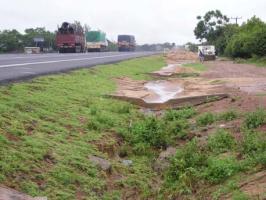 |
| Run-off water from a tarmac road. |
|
© E. Nissen-Petersen, Kenya
|
When designing a reservoir to hold water from a road catchment it is important that spillways can discharge safely the overflowing water during storms.
For example: A rain storm of 75 mm falling on a 2 km long road produces about: 75 mm rain x 6 m x 2,000 m road minus 20% = 720,000 litres = 720 m3 of water.
If the storage capacity, such as a pond is 500 m3, then the spillways must be capable of discharging 220 m3 of water (720 minus 500) in a few minutes or the pond will be damaged or perhaps washed away by the flood of incoming water.
Catchment of rainwater from roads is potentially the cheapest water source in dryland where there are no sandy riverbeds (luggahs or wadis). Tarmacked roads produce more run-off water than dirt roads but the water may contain harmful tar components for people and livestock and should therefore be used for irrigation only.
There are two main types of storage, namely:
- Storage in reservoirs, such as ponds, earth dams and tanks.
- Storage in situ, that is in the voids between particles of soil and sand.
For further information on water storage click here
Evaporation, seepage and leakage
Almost every type of storage reservoir loses some of its stored water to evaporation, seepage or leakage.
Evaporation losses
Open water reservoirs, such as; tanks without roofs, ponds, earth dams and rock catchment dams, lose water due to evaporation. In hot and windy climates the evaporation rate may be over 3 mm per day which is equal to losing a depth of 0.9 metre of water in a month. Water tanks and rock catchments should therefore be roofed but that is not feasible for ponds and earth dams.
Rainwater stored in the voids between the sand particles of riverbeds is the most economical water storage because up to 350 litres (35%) of water can be extracted from 1 cubic metre of coarse sand while only about 10% of water can be extracted from fine structured sand because its voids are smaller.
In hot regions without sandy riverbeds, rainwater can be stored in situ between the voids between soil particles, e.g. downstream of ponds and earth dams or in terraced land or in seasonal macro and micro irrigation structures as described in "Water Storage".
Seepage losses
In addition to evaporation loses, water stored in ponds and earth dams also lose water to seepage through the floor of these reservoirs. Fortunately, some of the seepage loses from ponds and dams can be utilized by sinking a shallow well into a seepage area. However, the combined losses of seepage and evaporation during long dry seasons usually result in the ponds and earth dams drying up except for very large earth dams.
The seepage loses through the floor of ponds and earth dams can be partly sealed by either:
1. Covering the floor with clayey soil or cow dung followed by cattle driven over the floor for compaction.
2. Waiting for several rainy seasons to deposit layers of silt. Seepage losses from sand in riverbeds can be avoided if proposed construction sites with boulders and fractured rocks are rejected.
Leakage losses
Loss of water from leaking water tanks, water pipes, water taps should be prevented by using either bitumen paste or cement mortar.
Gutters
Many rainwater harvesting installations do not perform as well as expected because of unsatisfactory gutters. It is therefore important to give careful attention to the materials used, the way the gutters are fabricated and the way they are installed. Ways of fabricating and installing low-cost gutters are described below.
Semi-circular gutters
The best known gutter is semi-circular and made either of galvanized iron sheet or PVC. Gutters are laid in gutter brackets nailed onto facia-boards or in V-shaped tree branches nailed to the rafters with a gradient sloping towards the water tank. Bamboo and Sisal poles can also be used as gutters when split in two halves.
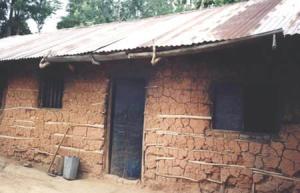 |
| Simple and cheap gutter laid in tree branches |
|
© E. Nissen-Petersen, Kenya
|
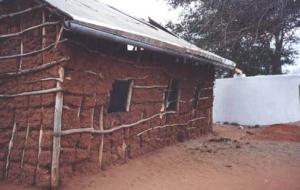 |
| Gutter suspended with a straight slope from a splash-guard nailed onto an uneven roof |
|
© E. Nissen-Petersen, Kenya
|
Splash-guards
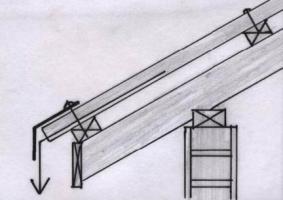 |
| A splash-guard, a strip of galvanized iron sheet, nailed onto the roof. |
|
© E. Nissen-Petersen, Kenya
|
They prevent rainwater from over-shooting gutters. They are made of strips of iron sheets bent at an angle and nailed onto the roof. Gutters are suspended with from the splash-guard using galvanized wires.
How to make and install Gutters with Splash-Guard
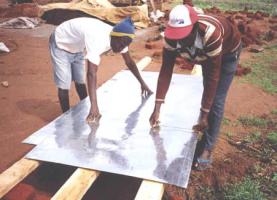 |
| Marking an iron sheet into three stripes with a wire |
|
© E. Nissen-Petersen, Kenya
|
Cut galvanized plain iron sheets of gauge 26 or 28 into three strips, each being 200 cm long and 33.3 cm wide by marking the sheets with a thick wire, about 40 cm long, with each end having a sharp bend and a pointed end to scratch a line. The distance between the two bends must be 33.3 cm in order to make equal width of the cut sheets.
-
The metal strips are bent over a U-shaped piece of iron and hammered into shape with a piece of wood or a mallet.
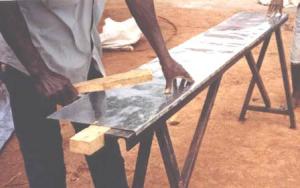 |
| Bending the edge of an iron sheet |
|
© E. Nissen-Petersen, Kenya
|
The shape of the metal strips depends on whether they shall be splash-guards or gutters with one of the shapes shown below: namely the V-shaped gutter, the square gutter and the semi-circular gutter.
 |
| From left to right: Splash-guard; V-shaped gutter; square gutter and semi-circular gutter |
|
© E. Nissen-Petersen, Kenya
|
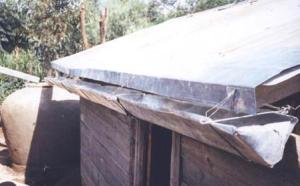 |
| V-shaped gutter suspended from a splash-guard. |
|
© E. Nissen-Petersen, Kenya |
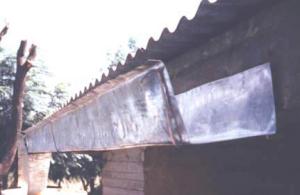 |
| Square gutter installed without splash-guard |
|
© E. Nissen-Petersen, Kenya
|
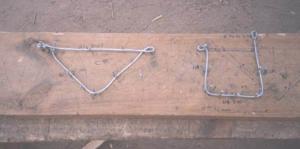 |
| Gutters are fitted into hangers made of 3 mm galvanised wires that are bent over nails hammered into a piece of wood. |
|
© E. Nissen-Petersen, Kenya
|
Gutters are fitted into hangers made of 3 mm galvanised wires that are bent over nails hammered into a piece of wood.
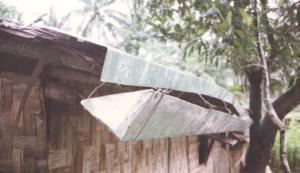 |
| Gutters fitted into hangers tied to a splash-guard nailed onto an uneven roof |
|
© E. Nissen-Petersen, Kenya
|
How to install Gutters
Gutters should be installed with a gradient of 10 cm depth for every 10 m length of a roof. This gradient of 1:100 will facilitate rain water running off the gutter with high velocity and no water will be wasted due to overflow. The high velocity of the water will transport leaves and debris to the inlet sieve without blocking the gutter.
 |
| Splash-guard being nailed into a roof |
|
© E. Nissen-Petersen, Kenya
|
 |
| Water level in a hosepipe filled with water |
|
© E. Nissen-Petersen, Kenya
|
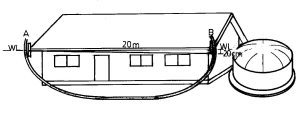 |
| The two water levels in the hosepipe filled with water gives an exact horizontal level |
| © E. Nissen-Petersen, Kenya |
A gutter hanger is tied to the splash-guard with its bottom at the level of the water in the hosepipe. A second hanger is tied to the other end of the splash-guard near the tank. This hanger is tied to the splash-guard with a slope 1:100 below the water level in the hosepipe.
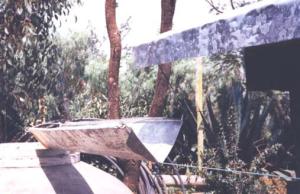 |
| The first gutter laid along a drawn string |
|
© E. Nissen-Petersen, Kenya |
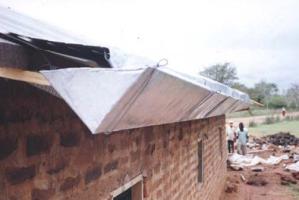 |
| Gutter laid in hangers |
|
© E. Nissen-Petersen, Kenya |
Two hangers are attached to the first gutter with one hanger at the middle and the other hanger at the end of the gutter. Bitumen is smeared on the inner end of first gutter before a second gutter is laid into it and so on until the whole length of gutter is installed.
Other Types of Gutters
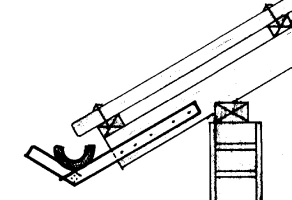 |
| PVC pipes or Bamboo cut in half can be laid in timber or branches nailed onto the rafters. |
|
© E. Nissen-Petersen, Kenya
|
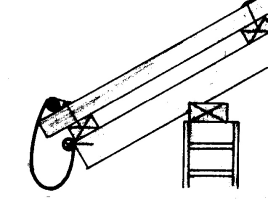 |
| One side of galvanised and corrugated iron sheets can be nailed to the rafters, while the sheets are held in position by galvanized wires tied to the roofing nails. |
|
© E. Nissen-Petersen, Kenya
|
Storage Reservoirs
The required storage capacity of a water reservoir depends on:
-
The daily required volumes and quality of water measured in litres.
-
The length of the dry seasons during which these volumes and quality of water are required.
Example on water demand for a homestead:
While the number of days in a dry season can be estimated fairly easy, such as 180 days without rain in a semi-arid region, the volume of water required for each of the 180 days can be calculated using the following guidelines on daily requirements of water for a rural homestead:
| Water users |
Daily requirements Litres |
Number of days without rains |
Required volume for a dry season Litres |
| 1 person | 15 | 180 | 2,700 |
| 1 grade cow | 50 | 180 | 9,000 |
| 1 local cow | 20 | 180 | 3,600 |
| 1 goat | 5 | 180 | 900 |
| 1 sheep | 5 | 180 | 900 |
| 1 hen | 0.3 | 180 | 54 |
| 3.3 mm on 4048 m2 (1 acre) with drip irrigation | 1,336 | 60 days x 1,336 | 80,150 |
| 5 mm on 4048 m2 (1 acre) with furrow irrigation | 2,024 | 60 days x 2024 | 121,440 |
| 4.3 mm on 4048 m2 (1 acre) with sprinkler irrigation | 1,741 | 60 days x 1741 | 104,460 |
(RELMA 2001, by I.V.Sijali)
A homestead with 6 persons, 4 local cows, 20 goats and sheep (shoats) and 20 hens who wants to irrigate 2023 m2 (¼ acre) with drip irrigation requires the following volume of water for a 180 days dry season without any rains:
| Litres | |
| Clean water from roof for domestic use: 6 persons x 2,700 L | 16,200 |
| Unclean water from a water hole in a riverbed: 4 cows x 3,600 L | 14,400 |
| Unclean water from a water hole in a riverbed: 20 shoats x 900 L | 18,000 |
| Unclean water from a ground tank or a pond: 20 hens x 54 L | 1,080 |
| Unclean water from a ground tank or a pond for irrigating ¼ acre: 80,150 x 1/4 | 20,038 |
| Total storage requirement | 69,718 |
| Add 20% loss due to evaporation and seepage | 13,944 |
| Total storage requirement for a 180 day long dry period | 83,662 |
1) A roof catchment tank with a storage capacity of at least 16,200 + 20% loss = 19,440 litres for fresh clean water for domestic use.
2) A well in a riverbed or a pond that can supply 14,400 + 18,000 + 1,080 + 20% loss = 40,176 litres of unclean and, perhaps, saline water for the livestock.
3) A ground catchment tank or a pond that can supply 20,038 + 20% loss = 24,046 litres of fresh but unclean water for drip irrigation.
For more information on water storage
Information Source Links.
- Agarwal, A. and Narain, S. (Eds) (2003). Dying wisdom. Rise, fall and potential of India's traditional water harvesting systems. State of India's Environment: a citizens' report. Centre for Science and Environment, New Delhi. ISBN 81-86906-07-X www.cseindia.org
- Anschuetz, J. and Nederlof, M. (Eds) (2001). Water harvesting and soil moisture retention. CTA Agrodok-series No.13. Technical Centre for Agricultural and Rural Cooperation ACP-EU. Agromisa Foundation ISBN 90-72746-75-9
- CTA (2007). Rainwater Harvesting for Increased Pasture Production. CTA Practical Guide Series, No.3. ISSN 1873-8192 www.cta.int
- Chleq, J.-L. and Dupriez, H. (1988). Vanishing Land and Water. Soil and water conservation in dry lands. Land and Life Macmillan Press Ltd, London. ISBN 0-333-44597-X
- De Vrees, L. 1987. Rainwater tank programme. Machakos Diocese, Box 640, Machakos, Kenya.
- Dupriez, H. and De Leener, P. (1992). Ways of Water: Run-off, Irrigation and Drainage. Land and Life Macmillan Press Ltd, London. ISBN 0-333-57078-2 (UK)
- Enyatseng, G. (1998). Evaluation of ferrocement water tanks. Botswana Technology Centre, P/Bag 0082, Gaborone, Botswana.
- Gould, J and Nissen-Petersen, E. (1999). Rainwater catchment systems for domestic supply. Intermediate Technology Publications, London, UK.
- Gould, J. (1987). Assessment of roof and ground catchment systems in Botswana. 3rd IRSA Conference, Khon Kaen University, Thailand.
- Gould, J. (1991). Rainwater catchment systems for household water supply. ENSIC Review, A.I.T. Bangkok, Thailand.
- Gould, J. (1995). Development in rainwater catchment systems in eastern and southern Africa. 7th IRSA Conference, Beijing China.
- Gould, J. (1998). Review of recent developments in rainwater catchment systems technology in eastern and southern Africa. Science, Vol. 16, No.1.
- Gould, J. an . Intermediate Technology Publications Ltd, UK. ISBN 1 85339 456 4
- Hasse, R. (1989). Rainwater Reservoirs above ground structures for roof catchments. GATE, Germany.
- Hatibu, N., Mahoo, H. F. (Eds) (2000). Rainwater harvesting for natural resources management. A. planning guide for Tanzania. RELMA Technical handbook No.22. Sida Regional Land Management Unit, Nairobi, Kenya. ISBN 9966-896-52-X
- Lee, M. and Nissen-Petersen, E. 1989. The use of low-cost self-help rainwater harvesting systems for community water supply in southern Kenya. 4th IRCA Conference, Manila, Philippines.
- Lee, M. and Visschers, J.T. 1990. Water harvesting in five African countries. IRC, The Hague, Netherlands.
- Malesu, M.M., Sang, J.K., Odhiambo, O.J., Oduor, A.R. and Nyabenge, M. (2006). Rainwater harvesting innovations in response to water scarcity: The Lare experience. Technical Report No.32. Regional Land Management Unit, Nairobi, Kenya. ISBN 92 9059 197 8
- Ngigi, S.N. 2003. Rainwater Harvesting for Improved Food Security. Greater Horn of Africa Rainwater Partnership and Kenya Rainwater Association, Nairobi.
- Ngigi, S.N. 2003. Rainwater Harvesting for Improved Food Security. Greater Horn of Africa Rainwater Partnership and Kenya Rainwater Association, Nairobi.
- Nissen-Petersen, E. (1982). Rain Catchment and Water Supply in Rural Africa: A Manual. Hodder and Stoughton, Great Britain. ISBN 0340-28429-3.
- Nissen-Petersen, E. (2006). Water from Dry Riverbeds. How dry and sandy riverbeds can be turned into water sources by hand-dug wells, subsurface dams, weirs and sand dams. Kenya.
- Nissen-Petersen, E. (2006). Water from Roads. A handbook for technicians and farmers on harvesting rainwater from roads. Kenya.
- Nissen-Petersen, E. (2006). Water from Rock Outcrops. A handbook for engineers and technicians on site investigations, designs, construction and maintenance of rock catchment tanks and dams. Kenya.
- Nissen-Petersen, E. (2006). Water from Small Dams. A handbook for technicians, farmers and other on site investigations, designs, cost estimates, construction and maintenance of small earth dams. Kenya.
- Nissen-Petersen, E. (2007). Water from Roofs. A handbook for technicians and builders on survey, design, construction and maintenance of roof catchments. Kenya.
- Nissen-Petersen, E. 1982. Rain catchment and water supply in rural Africa. Hodder & Stoughton, London, UK.
- Nissen-Petersen, E. 1990. Water tanks with guttering and hand-pump. Manual No. 1 of Harvesting Rainwater in Semi-arid Africa. Danida, Kenya
- Nissen-Petersen, E. 1992. How to an underground tank with domes. ASALCON, Kenya.
- Nissen-Petersen, E. 1992. How to build cylindrical tanks with domes. ASALCON, Kenya.
- Nissen-Petersen, E. 1992. How to build smaller water tanks and jars. ASALCON, Kenya.
- Nissen-Petersen, E. 1992. How to make and install gutters with splash-guard. ASALCON, Kenya.
- Nissen-Petersen, E. 1992. How to repair various types of water tanks. ASALCON, Kenya.
- Pacey, A. and Cullis, A. (1986). Rainwater Harvesting: the collection of rainfall and runoff in rural areas, IT Publications.
- Pacey, A. and Cullis, A. (1986). Rainwater Harvesting: the collection of rainfall and runoff in rural areas,.IT Publications.
- Teyssier, A. (2001). Establishing and managing waterpoints for village livestock. A guide for rural extension workers in the sudano-sahelian zone. CTA Agrodok-series No.27. Technical Centre for Agricultural and Rural Cooperation ACP-EU. Agromisa Foundation ISBN 9907246-90-2
- Water, Engineering and Development Centre (WEDC) (1998). The worth of water: Technical briefs on health, water and sanitation. IT Publications, London. ISBN 1 85339 069 0.
- Water, Engineering and Development Centre (WEDC) (1999). Running water: More technical briefs on health, water and sanitation. Edited by Rod Shaw. IT Publications, London. ISBN 1 85339 450 5.
- Watt, S. 1978. Ferrocement water tanks and their construction. ITDG London, UK
Contact Links
- Lanka Rainwater Harvesting Forum: www.rainwaterharvesting.com
- The Web of Rain: www.gdrc.org
- Water for Arid Land: www.waterforaridland.com

